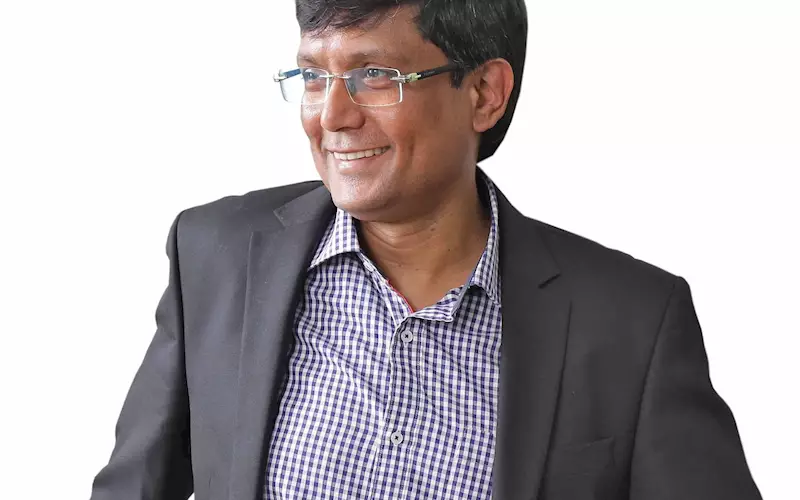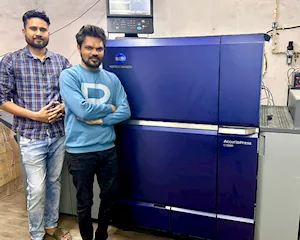I was part of the recently concluded MMS Roundtable Conference event, where Amit Shah, managing director of Spectrum Scan, made a presentation on outdoor media. Before the conference, he gave the PrintWeek India team a sneak-peek into his digital media initiative, which he calls – “Figital”., Business
Shah remains passionately immersed in doing new things at Spectrum Scan, where he specialises in producing POS/POPs using plastic material, despite fiercely debated environmental concerns about the material. “Many say plastic is not eco-friendly, but it’s certainly recyclable. The only thing is it has to be collected properly. Plus, what is lost in the recycling debate is that to recycle paper and paperboard, you use a lot of water, while in plastic, you don’t.”
Spectrum began its journey in print as a conventional pre-press before investing in CTP. The company always did something different. “Even in the CTP business, we only charged for the shot/exposing cost. The plates were supplied by our clients. This was also a sort of first in India,” says Shah.
Coming back to the use of plastic, Spectrum Scan had a reason. “What the market wants is – sastha, sundar and tikau. They want quality product at a good price,” says Shah. He and his team that had Rajgopal, the general manager, started searching for the best options available and that oligopolistic corner of niche in the print segment came from screen and plastic.
From the day first, Shah was clear that the company wanted to print CMYK using screen printing, exactly like offset, and at that time, very few printers did it. Shah says producing POP/POS elements using plastic is a journey, which begins with a concept based on a design to form a structure and shape. “When we introduced screen printing on plastic (sunboard PP sheet) in the POP/POS segment, it was not an easy idea to sell. We argued: since inkjet digital printing would cost three times higher than screen printing directly on the required POP/POS material, add to it the benefits of bright colours, durability and high quality, it made more sense to use the screen process. The idea clicked and the demand for these posters grew. So did volumes,” Shah says.
From pre-press, which started with positives, moving into CTP, printing with screen, Spectrum added digital and then thermoforming. “We used to provide flat print jobs, which for us was two-dimension. We thought to ourselves, and said, why not introduce a third-dimension. So, with thermoforming came – print and form. We stuck to printing on non-paper even with offset. People said, plastic is a very difficult substrate to print on. And we based our business on the premise: Where paper ends, we start,” he adds.
Dabbling with opportunities
Shah says he believes in taking the road less travelled. “It certainly is loaded with risks and challenges, but the rewards are satisfying.”
Shah’s strategy here is seen as a mix of the two philosophies. First, get into a market where it can dominate, and second, create a “moat” – a barrier that offers stability and control over operations.
One way that Spectrum has improved their “moat” is with backward integration. Nine months ago, Spectrum invested in a plastic extrusion plant. After getting the required permission and arrangements in place, the plant is now churning HIPS (high-impact polystyrene) used for POP elements like producing thermoform trays, industrial panel requirements, ABS (acrylonitrile butadiene styrene), a common thermoplastic polymer, and PP materials.
By manufacturing plastic material in-house, Shah says, Spectrum has been able to develop newer material. For example, for a telecom company's campaign, Spectrum produced Polysin (a PP-based affordable replacement for expensive material like polycarbonate), a translucent, unbreakable material with greater outdoor life.
Shah says even though the end cost of producing the plastic may be the same as buying it from the market, there are three benefits of manufacturing it in-house. “The quality is superior, there’s timely delivery of input material, and we are able to maintain secrecy of our designs.”
As a result, Spectrum is now producing material, colour and characteristic of which is drastically better than what was being outsourced. “We have better control over the type of raw material we use to produce extrusion sheets, because of which the base of the product has improved, resulting in vibrant prints,” says Rajgopal, the general manager at Spectrum.
The extrusion plant is capable of producing 125 tonnes of different sheets up to 5mm thickness.
A new domain
Generally, when one of the business segments seems to stagnate, the CEOs start looking at different segments. Was that the case with Spectrum? “No,” says Shah. “When we were doing pre-press work, we had moved into screen and digital. Our specialisation in pre-press helped us understand and execute better in both screen and digital, and subsequently, offset.”
The real reason, Shah says, was the backward integration of manufacturing plastics in-house that gave a solid base to Spectrum’s packaging idea. “POP is cyclic, but the packaging is an ongoing, predictable business. Our intent is to go for a product-based line with innovation,” he says.
Rajgopal explains that for packaging, the company will utilise both the offset and screen thermoforming processes and of course, post-press.
The pre-owned Roland 706 six-colour plus coater Spectrum has invested in was used to produce security-based cards. So the machine is ready for speciality work like plastics, which will run UV-based inks. A refurbished die-cutting machine (Bobst) and folder-gluer will soon be installed.
Two new Sakurai screen printing presses have been installed, which will provide post-print effect to the packaging.
The cartons would range from 300 to 800 microns thickness. “We are looking at exclusive products because we may not be able to match the price of paperboard cartons. But our products would bring a new look and feel to the table,” says Rajgopal.
Spectrum will mostly be producing promotion packs. For example, if the FMCG is producing millions of mono carton packs, part of it will be PP. “We have been producing promotional packs for FMCG, which is used for different occasions,” says Shah.
Was there a market demand? “No,” says Rajagopal. “We create one for the market. We see the trend and the requirements, and always think on what new to introduce in the market. What next is the question that pushes us.”
Packaging with paper is a normal course, but Spectrum chose plastic because of the niche factor. “We will not be doing regular packaging. We will put thermoforming, or other processes of prints that are required for the packaging to stand out,” Shah explains. “Our packaging will be re-usable too. For example, these plastic packaging can be used as pencil stand or be used for other house-hold purposes.
What are the advantages of using plastic in packaging? Plastic is transparent, so the product will be visible, effectively reducing the process of window patching. It is waterproof. Plus, it has the advantage of weight and its non-tearable. “A thin sheet of plastic can have an equivalent strength of a thick paperboard. The load capacity is better even in a lower micron plastic carton,” Shah says. “Packaging is engineering and when it comes to plastic packaging it is even more. You have to plan it better.”
Re-engineering Spectrum
Spectrum is in the process of re-engineering the complete set-up by bringing in modules right from bottom to top – segregating operations, training, R&D, as well as expert guidance that will help create a network more suited to its business in the next decade or so.
The company’s four units in Vasai’s industrial area spread across one-lakh sq/ft space are being streamlined.
“We see the client’s requirements. If we supply the same thermoformed product, the excitement levels may fade. There was a strong thinking that this re-engineering was going to be needed because we have to create something new every time,” says Shah.
Spectrum would perhaps be the only printer producing print jobs using the three processes – screen, digital and offset on plastic, extending it to metal and wood too.
And training is a big part of this re-engineering. “We knew that the type of people we need to carry out our work would have to be skilled. We developed a team and trained them. Even today, training is a regular process. We always say we are at zero, we want to learn more,” says Rajgopal.
Rajgopal adds that in a male-dominated industry, Spectrum prides on its inclusiveness, with 35 women employee representing a substantial number in its workforce.
And it is this inclusiveness that is driving Shah, Rajgopal and their team to excel. There are other attributes too. Back in 1987-88, Spectrum became popular as a conventional pre-press house, which helped leap into CTP, then screen printing, digital, thermoforming and offset. Now it hopes to stand for something larger in the world of packaging.





















 See All
See All